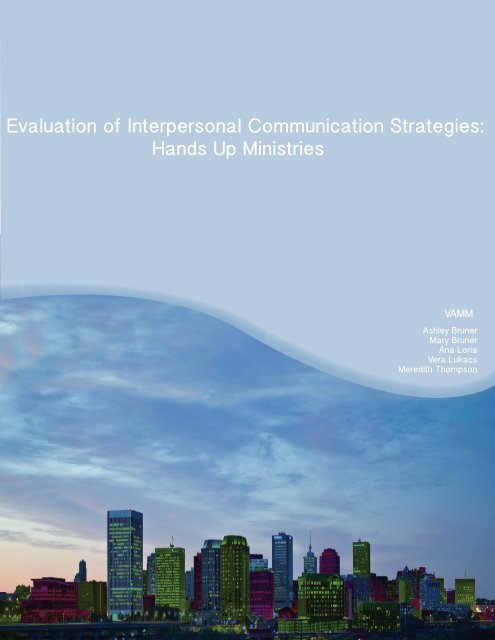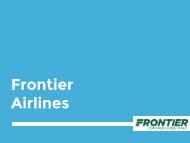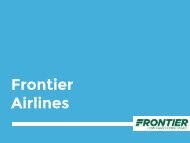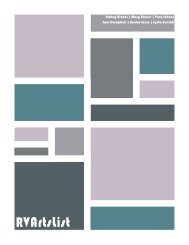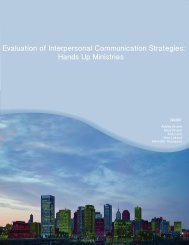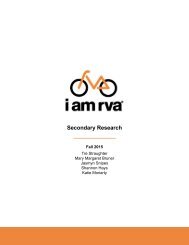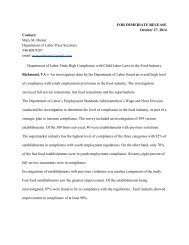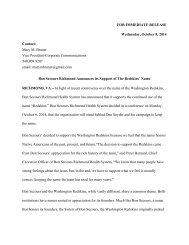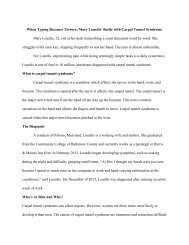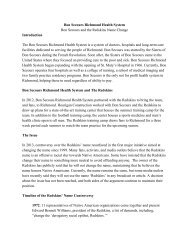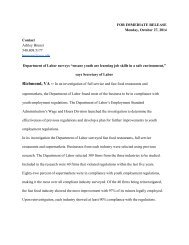vammproject4 (1)
- No tags were found...
Create successful ePaper yourself
Turn your PDF publications into a flip-book with our unique Google optimized e-Paper software.
Evaluation of Interpersonal Communication Strategies:<br />
Hands Up Ministries<br />
shley Bruner | Mary Bruner | Vera Lukacs | Ana Loria | Meredith Thompson<br />
VAMM<br />
Ashley Bruner<br />
Mary Bruner<br />
Ana Loria<br />
Vera Lukacs<br />
Meredith Thompson<br />
vA<br />
MM
Table of Contents<br />
3<br />
4<br />
5<br />
7<br />
9<br />
Executive Summary<br />
Client Summary<br />
Project Summary<br />
Method: In-Depth Interview<br />
Method: Survey<br />
12 Method: Content Analysis<br />
15<br />
Insight Summary<br />
16<br />
Recommendations<br />
18<br />
Appendix<br />
vA<br />
MM
Executive Summary<br />
When VAMM first met with Hands Up Ministries they communicated various goals they had for their organization.<br />
As an organization, they work on numerous small projects while also focusing on their main goal of<br />
refurbishing blighted housing. HUM needed more volunteers, more donors, more media, and most importantly,<br />
they needed help building stronger lasting relationships with the community. That is where VAMM came in.<br />
Moving forward, we needed to establish specific components of HUM’s relationship with the community<br />
that needed improvement, and also figure out what they were doing that worked. Additionally,<br />
we wanted to compare HUM’s interpersonal communication strategies with those of other nonprofits.<br />
To find out where HUM currently stood with their interpersonal communication strategies,<br />
we decided it would benefit the organization to get insight from three different perspectives:<br />
Members of the organization<br />
The community it serves (Highland Park)<br />
Other nonprofits<br />
First, we established what members of Hands Up Ministries’ staff thought the organization was doing<br />
right, and what they needed to work on by doing in-depth interviews with four of the staff members.<br />
The thoughts and ideas of those directly associated with HUM were useful because they allowed<br />
VAMM to tailor communication strategies to fit the personality of the organization.<br />
Second, we surveyed members of the Highland Park community to gauge their attitude<br />
towards Hands Up Ministries. VAMM developed a set of questions designed to determine<br />
HUM’s current relationship status with the community. Additionally, we included<br />
questions to gauge how much time and energy the community is willing to commit to HUM.<br />
Finally, we analyzed both traditional and alternative media to determine the normal<br />
level of communication other nonprofits have with their community. Our content<br />
analysis included both traditional media (i.e. newspaper articles) and alternative<br />
media (i.e. nonprofits’ websites. Through coding, we sought to determine what<br />
communication strategies other nonprofits used. This allowed us to determine their effectiveness.<br />
3<br />
vA<br />
MM
Client Summary<br />
Hands Up Ministries is a non-profit 501(c)3 organization based in Richmond, Virginia. Started in<br />
2008 by Cassie Matthew and her husband, JT, HUM is focused on providing affordable housing in<br />
the Richmond community. To accomplish this goal, HUM purchases blighted homes and sells them<br />
to under privileged persons and families. Because HUM purchases the houses with cash, the organization<br />
is able to finance the homes for the families without an overseeing financial institution.<br />
“To change lives by providing affordable, stable housing opportunities<br />
for Richmond’s underserved.”<br />
-mission statement, Hands Up Ministries<br />
Goals and Objectives<br />
Hands Up Ministries has a multi-faceted goal aimed at bettering the Richmond community<br />
as a whole. A major facet of the organization’s goal is to purchase blighted homes, upgrade<br />
them, and sell them to underprivileged members of the community. HUM hopes that by<br />
being the sole institution involved in financing the houses, its beneficiaries will learn necessary<br />
skills to be responsible homeowners and renters in the future. To complement this<br />
goal, HUM also offers financial advising to members of the community. The overarching goal<br />
of HUM is to provide an opportunity for stability for all members of the Richmond community.<br />
Primary Beneficiaries of Hands Up Ministries<br />
Hands Up Ministries aims to serve all underprivileged and impoverished members<br />
of the community. However, to accomplish this goal, HUM focuses on one city<br />
block at a time. Currently, HUM is focused on empowering members of the Highland<br />
Park Community on 42nd street. Apart from its peers, Hands Up Ministries<br />
does not discriminate against persons with prior criminal records. As a charitable<br />
organization, HUM hopes to provide felons with an opportunity for stability.<br />
4<br />
vA<br />
MM
Project Summary<br />
Situation Analysis<br />
When VAMM began work with Hands Up Ministries they were in need of an update to their website,<br />
social media and interpersonal communication campaigns. In the realm of interpersonal<br />
communication, Hands Up Ministries lacked diverse and overarching methods of building relationships<br />
with the Highland Park community. While HUM does a consummate job securing<br />
a steadfast relationship with a small section of the Highland Park community, their efforts neglected<br />
an outlying section. Our goal in conducting research within the community was to aid<br />
HUM in developing efficacious methods of reaching members previously unaffected by their<br />
efforts. Specifically, VAMM’s research focused on tailoring methods for Cassie Matthew, president<br />
of Hands Up Ministries. HUM foundered in their communication methods by choosing to involve<br />
themselves in numerous engagements rather than injecting their full energy and attention<br />
into one project. This method led to attenuated efforts within each project HUM took on.<br />
Communication Objectives<br />
VAMM’s top priority when working with HUM was to evaluate how they, specifically Cassie Matthew,<br />
communicates and build relationships with the community members in Highland Park.<br />
Our first objective was to look inside the organization itself to see how the staff members view<br />
the work they produce for the community in Highland Park. We then went on to survey the community<br />
members in Highland Park to grasp their perspective on the work HUM does and how they<br />
interact with a nonprofit organization within their community. Lastly we coded websites and tra-<br />
5<br />
vA<br />
MM
Research Questions<br />
After we determined Hands Up Ministries’ communication objectives, we developed three specific<br />
questions we needed to answer through our research. The questions we sought to answer are as follows:<br />
What is the most effective way for Cassie Matthew to reach the Highland Park Community?<br />
What are the best ways to build a relationship with the community?<br />
How much does a community interact with non-profit organizations?<br />
Research Methods<br />
To answer our three specific research questions, VAMM used three different research methods.<br />
The methods used included in-depth interviews, surveys and content analysis of related traditional<br />
and social media. First, we interviewed members of Hands Up Ministries to gather their<br />
thoughts and ideas on effective methods for Cassie to use in communication with the Highland<br />
Park community. Second, we surveyed members of the community to figure out the best way to<br />
build a relationship with the Highland Park community. Finally, we examined news articles relating<br />
to non-profits and nonprofits’ websites to determine their level of interaction with the community.<br />
6<br />
vA<br />
MM
Qualitative Methods of Research<br />
Method Selection<br />
VAMMs qualitative method was to provide in-depth interviews to the staff members and volunteers with HUM.<br />
Our goal was to evaluate the internal perspective of the staff on how effective Cassie Matthew is in communicating<br />
with the community in Highland Park.<br />
Data Collection<br />
Our goal was to interview the staff members and volunteers of HUM. VAMM got in contact with Debbie<br />
Ireland, the executive administrator, to send out our in-depth interview to their volunteers and other<br />
staff members. With the limited amount of staff employed at HUM, we received back four interviews.<br />
The Interview Protocol: Interviewees had to be involved with the organization’s day-to-day internal operations<br />
as a staff member, intern or volunteer.<br />
Data Analysis<br />
Vision of the Organization<br />
The interviewees came to a consensus on a short term goal for HUM: to be able to purchase<br />
and sell at least one house per year in Highland Park. By purchasing, refurbishing -- and eventually<br />
selling -- homes to families, HUM hopes to develop a heightened knowledge of home ownership<br />
skills in the Highland Park community. In five years, the interviewees see the organization<br />
purchasing and refurbishing more than one home per year. Particularly, interviewees hope for<br />
Hands Up Ministries to own 10 homes on 4th and 5th avenue. Making home ownership possible<br />
and seeing a positive change within the community is the overall vision. However, the interviewees<br />
feel that Hands Up Ministries needs to focus their time and energy on the vision of the organization,<br />
providing affordable housing, instead of taking on issues outside of the organization’s purpose.<br />
Interviewee #1:<br />
“Short term – to be able to purchase and refurbish at least one home per year (minimum) to be able to provide<br />
a family with affordable housing.”<br />
Interviewee #2:<br />
“To have ten homes sold to families living on 4/5th Ave in 5 years total.”<br />
Interviewee #3:<br />
“To buy up abandon/foreclosed homes on 4th & 5th Avenues, provide affordable rents in these homes,<br />
eventually sell these homes to the tenants, and watch the neighborhood become revitalized.”<br />
Interviewee #4:<br />
“Being able to purchase at least one home per year. And secondly, be able to sell at least one of the HUM<br />
homes each year to someone in the community to develop home ownership.”<br />
7<br />
vA<br />
MM
C o m m u n i c a t i o n<br />
Door-to Door communication, such as handing out flyers to residents of Highland Park, wordof-mouth<br />
and social media are the methods the interviewees have found most effective in<br />
reaching the community.<br />
Within the organization the most effective methods of communication<br />
mentioned were face-to-face and email. Respondents noted, however, that HUM experiences<br />
internal communication problems. Interviewees noted that the lack of effective internal communication<br />
has led to difficulty making decisions and a lack of commitment by the volunteers.<br />
Interviewee #1:<br />
“Reality is there are only 3 people (Cassie, Debbie, and JT) that are making decisions for the organization.<br />
Face to face communication has been most effective; emails as well. Social media has been most effective<br />
for communication to volunteers and supporters.”<br />
Interviewee #2:<br />
“Word of mouth by a reliable community neighbor.”<br />
Interviewee #3:<br />
“Flyers given out to the neighborhood by Lena & Loretta, residents; word-of-mouth”<br />
Interviewee #4:<br />
“Direct contact; door-to-door. Use of social media.”<br />
F o c u s<br />
Hands Up Ministries needs to focus their time and energy on the vision of the organization,<br />
providing affordable housing, instead of taking on issues outside of the organization’s purpose.<br />
Interviewees felt that Hands Up Ministries could most effectively allocate their resources<br />
by focusing their money on purchasing homes and completing necessary repairs in those<br />
homes. Realigning the board members and specifying their responsibilities would create more<br />
organization within HUM. The general consensus was the the organization is taking on too<br />
much and have too small a staff<br />
to effectively and successfully complete all those tasks.<br />
Interviewee #1:<br />
“It can pull the focus away from HUM’s prime mission (to provide affordable housing) and divert our limited<br />
resources (people) from working on the prime mission.<br />
Interviewee #2:<br />
“Little libraries are a huge hit, but the return of books is almost nill. Empowering neighbors to take over the<br />
library will help.”<br />
Interviewee #3:<br />
“I think they can limit our resources and potentially take funding from our mission. However, they can also<br />
help us get to know the community better if we are careful with the projects we choose and try not to do<br />
everything.”<br />
Interviewee #4:<br />
“Sometimes it can be a drain on people resources and cause HUM to get off track from their primary mission<br />
(providing affordable housing).”<br />
8<br />
vA<br />
MM
Survey Method<br />
Method Selection<br />
When we first met with Hands Up Ministries we identified a fundamental problem that needed to be<br />
solved: what are the community’s attitudes towards HUM and what can HUM do to change or improve<br />
on those attitudes. Simply, Hands Up Ministries needed to figure out the most effective ways to build relationships<br />
with members of the community. We decided that the most reliable way to gauge the community’s<br />
attitudes and level of engagement with HUM was to survey members of the community.<br />
Sampling Strategy<br />
Hands Up Ministries serves the relatively small community of Highland Park. Because the community<br />
is small we decided to survey as many people as possible. In order to reach a sufficient amount of<br />
community members, we enlisted the help of Hands Up Ministries’ community liaison, Loretta Wallace.<br />
Participation Recruitment<br />
After considering different options, we decided that the most effective way to ensure participation<br />
would be the use of Hands Up Ministries’ community liaison, Loretta Wallace. We developed<br />
and printed the surveys, then scheduled a meeting with Loretta Wallace. Mrs. Wallace<br />
agreed to distribute the surveys to members of the community at HUM’s community garden<br />
clean-up. After the event, we reconnected with Mrs. Wallace and collected the completed surveys.<br />
Analysis and Results<br />
When asked to rate their level of involvement in community events on a scale of one<br />
to ten, most participants rated their involvement in the community at four out of ten.<br />
Meaning, he/she participates in community events occasionally.<br />
9<br />
vA<br />
MM
66% of participants indicated they are willing to dedicated one to five hours per<br />
week to volunteering at HUM.<br />
How much time are you willing to commit to HUM?<br />
None<br />
58%<br />
1-5 Hours per week<br />
17%<br />
5+ Hours a week<br />
17%<br />
When asked whether most people can be trusted, the majority of participants said that you<br />
can’t be too careful when dealing with people.<br />
The majority of participants, 58%, indicated that trust is something earned over<br />
time, specifically six months to a year.<br />
10<br />
vA<br />
MM
When asked to rate their view of Hands Up Ministries’ presence in the community<br />
on a scale of one to ten, one being negative and ten being positive, 82% of participants<br />
chose “7” or more.<br />
The majority of participants have lived in the city of Richmond for at least one year, and 42%<br />
have lived in the city for at least 10 years.<br />
The majority of participants, 41%, get their news from the Internet.<br />
83% of participants said they would attend a community meeting.<br />
The majority, 25%, of participants said they are not at all involved in HUM.<br />
When asked, on a scale of one to ten, how important it is that, in their personal<br />
relationships, the other person dedicates time to them the majority of participants<br />
answered “seven.” Meaning, it is important but not imperative that the other person<br />
dedicates time.<br />
11<br />
vA<br />
MM
Content Analysis Method<br />
Method Overview<br />
VAMM analyzed newspaper articles and websites of nonprofit organizations from November 2011 to<br />
November 2014. In our analysis of newspaper articles, VAMM examined the attitude of the media towards<br />
nonprofit organizations. Specifically, we sampled news articles containing keywords pertaining<br />
to affordable and low income housing. Tailoring our sampling to be more saturated produced<br />
a broad insight into how the media perceives organizations similar to Hands Up Ministries. Additionally,<br />
VAMM studied how nonprofit organizations represent themselves on their websites. In our examination<br />
we looked at how these organizations portray their events and internal news to the public. After<br />
inputting the data into spreadsheets, we were able to gather statistics on the whole of our data sets.<br />
Sampling Strategy and Data Selection Process<br />
For our content analysis of newspaper articles we used the web database LexisNexis to compile a sampling.<br />
We set our search dates to begin in November of 2011 in order to gather current and relevant information.<br />
To cover a broad selection of news articles, we used three different keywords in our search.<br />
“Non-profit” produced 1,000 results, “affordable housing organization” produced 84 results and “charitable<br />
organization” produced 1,000 results. The results were sorted based on relevance. In our research<br />
of non profit websites, we selected every other non profit on a list of 100 throughout the world. This<br />
list allowed us a random selection of nonprofits here and abroad. From that list we coded 50 websites.<br />
Data Analysis<br />
While 67.3% of the articles featured a quote from a member of the nonprofit, only 22.4% of<br />
the articles featured a quote from a member of the community.<br />
55% of the articles took a positive tone towards the non profit and 28.6% had a<br />
neutral tone towards the non profit. Only 16.3% took a negative tone towards the<br />
community.<br />
Towards the community, the majority of the articles-- 63.2% took a neutral tone<br />
towards the community. Only 8.2% of the articles painted the community in a negative<br />
light, while 28.6% painted the community in a positive manner.<br />
12<br />
vA<br />
MM
96% of articles did not mention a community liaison between the community and<br />
the organization.<br />
Articles were almost evenly split in the presence of mentions of a relationship between the<br />
community and the non profit. 44.8% mentioned a relationship and 55.2% did not mention a<br />
relationship.<br />
13<br />
vA<br />
MM
Webistes of Nonprofits<br />
82% showed some kind of relationship or partnership with another organization.<br />
Vision and mission made very clear--usually the first item on drop down menu.<br />
62% of the websites had biographies of staff members. However, the majority of<br />
the 62% of websites with biographies on the staff were websites of smaller non<br />
profits.<br />
Almost all, 98%, of the websites had links to social media. In general, the links were either at<br />
the topmost or bottommost sections of the page.<br />
60% of websites had their upcoming events clearly displayed on the home page.<br />
Intercoder Reliability<br />
To ensure the accuracy of our data, a second set of coders went through each item<br />
and recoded it. We then compared the intercoder’s numbers to those of the original<br />
coder. When we used the formula R = 2M / N1 + N2, R is the level of similarity between<br />
the intercoder and coder’s numbers, or the intercoder reliability. R = .01 being 1%<br />
similar and R = 1.0 being 100% similar. The intercoder relibaility, R, for the newspaper<br />
article data set is 89%. For the nonprofit websites the intercoder reliability is 92%.<br />
14<br />
vA<br />
MM
Insights Summary<br />
While we found a substantial amount of information during our content analysis, we had<br />
limited resources for interviews and disseminating surveys to the Highland Park community<br />
was difficult. We reached out to the HUM staff and the community members living<br />
in Highland Park. Although both the Highland Park community members and the<br />
HUM staff are limited, both groups were very willing to participate in our research.<br />
The HUM organization only has 3 people on staff, that being Debbie Ireland, Cassie Matthew and her<br />
husband JT, and only a handful of volunteers and interns. We were able to retrieve 4 interviews back.<br />
We received constructive assessment about the organization from an internal point of view which<br />
allowed us to better understand where HUM shortcomings are within the organization. We found that<br />
most of the staff members and volunteers believe that HUM spends their energy on side projects and<br />
that it has the tendency to distract them from their main objective-- to provide affordable housing.<br />
When it came to disseminating the survey, we were able to reach 12 participants from Highland<br />
Park. We went through HUM and Highland Park community liaison, Loretta Wallace, who was<br />
more than willing to help us with our dissemination. Our overarching theme of the survey was<br />
what the Highland Park community needed from HUM and Cassie specifically. In our research,<br />
we found that 58% of participants believed that you can’t be too vulnerable in trusting other<br />
people, which could be a potential problem for HUM in building relationships with the community.<br />
In our analysis of newspaper articles, wed found a severe lack of a mention of reciprocal<br />
relationships. Most articles featured quotes from members of the organization, but lacked<br />
any input from members of the community they serve. Conent analysis of websites showed<br />
that most websites of nonprofits featured photos of community members on the homepage.<br />
Overall, mediated representaion of a reciprocal relationship faltered when the nonprofit was<br />
not in control of the content displayed.<br />
15<br />
vA<br />
MM
Recommendations<br />
Our evaluation of Hands Up Ministries’ interpersonal communication strategy, and subsequent research of the<br />
topic yielded three recommendations. They are as follows:<br />
Monthly community forums<br />
Suggestion box<br />
Newsletter<br />
Community Forum<br />
Monthly community meetings would provide a forum for the community to express their wants, needs, or concerns<br />
to Hands Up Ministries. Based on data acquired from surveying the Highland Park community, 58% of members<br />
are willing to commit one to five hours per week to HUM. That being said, a monthly community forum would likely<br />
be well received by the community. Community forums would be effective because they are a regularly occurring<br />
event where leadership of HUM is present. For Cassie Matthew, her presence at the monthly forums would<br />
provide not only firsthand information about what the community wants, but also time for her to build important<br />
relationships with the community. We believe monthly forums would be well received because they fit the time<br />
constraints express by community members in the surveys, they make community feel they are more involved<br />
in the decision-making process, and because they provide an opportunity for community members to interact<br />
with leadership. In addition, information gathered at the forums would help provide a focus for HUM’s projects.<br />
Suggestion Box<br />
The suggestion box would be an anonymous box for a form that the community members of Highland Park can<br />
fill out and leave at a designated spot in the neighborhood. The form would entail a short survey and a section<br />
where the community members can express their concerns and give suggestions. At the aforementioned<br />
monthly forums, leadership would have the opportunity to address the concerns and suggestions provided in<br />
the suggestion box. As interviewee number four said when asked to comment on communication strategies,<br />
face-to-face communication is the most effective way to communicate. However, because of availability and<br />
staff size restrictions, face-to-face communication opportunities are limited. The suggestion box acts a pseudo<br />
face-to-face form of communication, because the suggestions would be addressed at the monthly forums.<br />
16<br />
vA<br />
MM
Newsletter<br />
As staff members noted in their interviews, word-of-mouth communication is highly effective in spreading<br />
news and information about an organization. As the suggestion box functions as a pseudo face-to-face<br />
strategy, so would the newsletter function as a pseudo word-of-mouth strategy. Because word-of-mouth<br />
communication is already in place within the community, a newsletter would act as a catalyst to this preexisting<br />
communication strategy. A newsletter also presents the opportunity of community involvement in the<br />
manner of letters to the editor or op-ed pieces by community members. When asked how they access news,<br />
41% of respondents said they access news online and 41% answered either flyer or newspaper. Therefore,<br />
VAMM recommends a bi-monthly print newsletter to keep production costs low and a bi-weekly e-newsletter.<br />
Providing both forms of the newsletter on a consistent basis ensures that, no matter how they get their news,<br />
members of the community are well informed of events and news related to Hands Up Ministries.<br />
17<br />
vA<br />
MM
Appendix A: Qualitative Method<br />
Instruments<br />
1. What is your vision for the organization?<br />
2. In 5 years, where do you see the organization?<br />
3. What problems do you see the organization facing? Are any issues long term?<br />
4. What methods have you found are the most effective in communicating with the neighborhood?<br />
5. How do you feel Hands Up Ministries could most effectively allocate their resources?<br />
6. Within the organization, what methods of communication are most effective? Are there any shortcomings<br />
as far as effective communication between staff members?<br />
7. As an organization, how do you feel Hands Up Ministries has been received by the community?<br />
8. In what areas do you think the community needs the most help?<br />
9. How do you see the side projects Hands Up Ministries takes on affecting the organization?<br />
10. Currently, where does the community provide the most help?<br />
Transcripts<br />
Interviewee #1:<br />
1. What is your vision for the organization?<br />
“Short term – to be able to purchase and refurbish at least one home per year (minimum) to be able to pro<br />
vide a family with affordable housing.”<br />
2. In 5 years, where do you see the organization?<br />
“Long term – to be able to sustain that year after year and purchase multiple houses per year. Secondly, to<br />
be able to sell the homes to the families via rent-to-own agreements and financing (essentially HUM becomes<br />
the bank to the homeowner and provides low interest loans since many of the people we are trying to help have<br />
bad credit and would be hard pressed to qualify for conventional loans).”<br />
18<br />
vA<br />
MM
3. What problems do you see the organization facing? Are any issues long term?<br />
“Sustainable fundraising – being able to raise $50,000 or more per year to support the short and long term<br />
goals mentioned previously (possibly gain corporate sponsorship).”<br />
4. What methods have you found are the most effective in communicating with the neighborhood?<br />
“Face to face communication. Have also used flyers and social media.”<br />
5. How do you feel Hands Up Ministries could most effectively allocate their resources?<br />
“Money – focused on purchase of housing and necessary repairs to the housing.<br />
Manpower – need to realign the board members and assign areas of responsibility (get new board members<br />
and spread the work/responsibilities amongst them). Currently all work and planning are completed by Cassie,<br />
Debbie, and JT.”<br />
6. Within the organization, what methods of communication are most effective? Are there any short comings<br />
as far as effective communication between staff members?<br />
“Reality is there are only 3 people (Cassie, Debbie, and JT) that are making decisions for the organization.<br />
Face to face communication has been most effective; emails as well. Social media has been most effective<br />
for communication to volunteers and supporters.”<br />
7. As an organization, how do you feel Hands Up Ministries has been received by the community?<br />
“Well received. HUM has made commitments and lived up to those commitments. HUM has delivered on everything<br />
they said they would do, which has created credibility.”<br />
8. In what areas do you think the community needs the most help?<br />
“Financial management; better access to health care and grocery store options.”<br />
9. How do you see the side projects Hands Up Ministries takes on affecting the organization?<br />
“It can pull the focus away from HUM’s prime mission (to provide affordable housing) and divert our limited resources<br />
(people) from working on the prime mission.”<br />
10. Currently, where does the community provide the most help?<br />
“Care of the community garden. Garden was established to serve the community – some from the community<br />
have helped to weed and tend garden. Some members from the community have helped in repairs to HUM<br />
owned housing. Community involvement has been more centered on HUM serving the community vs the community<br />
providing help.”<br />
19<br />
vA<br />
MM
11. Where would you like to see the members of the community participate more?<br />
“Developing ideas or suggestions where HUM can help or coordinate resources to help develop the community.”<br />
Interviewee #2:<br />
1. What is your vision for the organization?<br />
“To have ten homes sold to families living on 4/5th Ave in 5 years total.”<br />
2. In 5 years, where do you see the organization?<br />
“I see us with 10 homes on 4/5th Ave, moving this community to work together to achieve<br />
more stable neighborhood.”<br />
3. What problems do you see the organization facing?<br />
“We have no paid staff, so infrastructure is always a problem. Keeping motivated board members. Are any<br />
issues long term? Again, keeping donors motivated to keep donating to the cause and to keep volunteers interested<br />
in helping long term. Obtaining long-term sponsors.”<br />
4. What methods have you found are the most effective in communicating with the neighborhood?<br />
“Word of mouth by a reliable community neighbor.”<br />
5. How do you feel Hands Up Ministries could most effectively allocate their resources?<br />
“Money purchasing homes.”<br />
6. Within the organization, what methods of communication are most effective?<br />
“Email and facebook Are there any shortcomings as far as effective communication between staff members?<br />
Yes, “staff” is minimal. And there is just not enough time. This is a fulltime job for me, no one else. Commitment.<br />
With the exception of Debbie Ireland is low.”<br />
7. As an organization, how do you feel Hands Up Ministries has been received by the community?<br />
“I think with the people we have encountered, we have been well received.”<br />
8. In what areas do you think the community needs the most help?<br />
“Empowerment, getting things done, taking a leadership role in their issues. Need to get more homeownership,<br />
which will have rippleffect on the way neighbors take ownership of the neighborhood.”<br />
20<br />
vA<br />
MM
9. How do you see the side projects Hands Up Ministries takes on affecting the organization?<br />
“Little libraries are a huge hit, but the return of books is almost nill. Empowering neighbors to take over the<br />
library will help.”<br />
10. Currently, where does the community provide the most help?<br />
“Very little help is provided, unless we have a community clean up, otherwise it is not the community.”<br />
11. Where would you like to see the members of the community participate more?<br />
“Ownership of clean ups, problems, keeping their own property’s tidy, just involvement.”<br />
Interviewee #3:<br />
1. What is your vision for the organization?<br />
“To buy up abandon/foreclosed homes on 4th & 5th Avenues, provide affordable rents in these homes, eventually<br />
sell these homes to the tenants, and watch the neighborhood become revitalized.”<br />
2. In 5 years, where do you see the organization?<br />
“Making progress in renting affordable homes, seeing the neighborhood begin to change.”<br />
3. What problems do you see the organization facing?<br />
“Funding; Trying to take on things outside of our purpose – trying to do it all. Are any issues long term? Funding”<br />
4. What methods have you found are the most effective in communicating with the neighborhood?<br />
“Flyers given out to the neighborhood by Lena & Loretta, residents; word-of-mouth”<br />
5. How do you feel Hands Up Ministries could most effectively allocate their resources?<br />
“By sticking to our mission statement of providing affordable housing and not getting side tracked by other<br />
needs; limiting “one and done” mission/volunteer groups”<br />
6. Within the organization, what methods of communication are most effective?<br />
“Email, phone calls Are there any shortcomings as far as effective communication between staff members?<br />
Sometimes it is hard to keep up with all that is going on, especially if we take on things that are not really part<br />
of our mission statement.”<br />
21<br />
vA<br />
MM
7. As an organization, how do you feel Hands Up Ministries has been received by the community?<br />
“I think we have been well received. Lots of positives from neighbors.”<br />
8. In what areas do you think the community needs the most help?<br />
“Housing--Hard to say what else. I think we need to ask.”<br />
9. How do you see the side projects Hands Up Ministries takes on affecting the organization?<br />
“I think they can limit our resources and potentially take funding from our mission. However, they can also help<br />
us get to know the community better if we are careful with the projects we choose and try not to do everything.”<br />
10. Currently, where does the community provide the most help?<br />
“Honestly, other than a couple of residents, they don’t really help. If Loretta & Lena ask, help increases.”<br />
11. Where would you like to see the members of the community participate more?<br />
“Help with maintaining the Community Garden, help maintaining the Little Free Libraries, volunteer to help with<br />
Work Days.”<br />
Interviewee #4:<br />
1. What is your vision for the organization?<br />
“Being able to purchase at least one home per year. And secondly, be able to sell at least one of the HUM<br />
homes each year to someone in the community to develop home ownership.”<br />
2. In 5 years, where do you see the organization?<br />
“Very much the same answer as question 1. An organization that can help to make homeownership possible<br />
for members in the community.”<br />
3. What problems do you see the organization facing? Are any issues long term?<br />
“Raising capital to purchase multiple homes.”<br />
4. What methods have you found are the most effective in communicating with the neighborhood?<br />
“Direct contact; door-to-door. Use of social media.”<br />
22<br />
vA<br />
MM
5. How do you feel Hands Up Ministries could most effectively allocate their resources?<br />
“If we were able to purchase one home per year, then our resources would be focused on completing necessary<br />
repairs and helping the future tenants.”<br />
6. Within the organization, what methods of communication are most effective? Are there any shortcomings<br />
as far as effective communication between staff members?<br />
“Direct contact (face-to-face). Use of email.”<br />
7. As an organization, how do you feel Hands Up Ministries has been received by the community?<br />
“I think very well. HUM says they are going to do something, and then they deliver on that.”<br />
8. In what areas do you think the community needs the most help?<br />
“Repairs to their homes.”<br />
9. How do you see the side projects Hands Up Ministries takes on affecting the organization?<br />
“Sometimes it can be a drain on people resources and cause HUM to get off track from their primary mission<br />
(providing affordable housing).”<br />
10. Currently, where does the community provide the most help?<br />
“The community has provided help with projects we have done at 2000 4thAve. Having partners in the community<br />
has helped to do joint projects together.”<br />
11. Where would you like to see the members of the community participate more?<br />
“If we do a project /event that is for the community (ex. Alley cleanup and picnic), would like to see more members<br />
there.”<br />
23<br />
vA<br />
MM
Appendix B: Survey Method<br />
Instruments<br />
Research Question: What are the best ways to build a relationship with the community?<br />
Dear Residents,<br />
We are students at Virginia Commonwealth University conducting a study related to Hands Up Ministries and<br />
community involvement. We are researching more effective ways for Hands Up Ministries to interact with your<br />
community. Your participation in this survey would be much appreciated.<br />
Hands Up Ministries goal is to provide affordable, stable housing opportunities for Richmond’s under served.<br />
Currently Hands Up Ministries is purchasing and restoring damaged houses in Highland Park to prepare them<br />
for residency.<br />
The purpose of this survey is to provide Hands Up Ministries with information that will help them develop relationship-building<br />
strategies.<br />
This survey is completely anonymous and confidential. None of your information will be given out at any point.<br />
Instructions<br />
The questions in this survey are formatted in a way that provides the most useful information. If a question<br />
has multiple choices, please circle ONE that best applies to you. If the question asks you to rate your agreement<br />
on a 1 to 10 scale, please circle the number that best describes you.<br />
1. How often do you participate in community events? 1 being never and 10 being very frequently.<br />
1 2 3 4 5 6 7 8 9 10<br />
2. How much free time are you willing to commit to hands up ministries?<br />
a. None<br />
b. 1-5 hours per week<br />
c. 5+ hours a week<br />
3. In what way do you usually access local news and information?<br />
a. newspaper<br />
b. flyers<br />
c. internet<br />
d. word of mouth<br />
4. Would you attend a community meeting?<br />
a. yes<br />
24<br />
vA<br />
MM
. no<br />
5. How would you rate your current involvement in Hands up Ministries? 1 being not involved at all and 10<br />
being involved very frequently.<br />
1 2 3 4 5 6 7 8 9 10<br />
6. In your personal relationships, how important is it to you that the other person dedicate their time to you? 1<br />
being not important, 10 being extremely important.<br />
1 2 3 4 5 6 7 8 9 10<br />
7. Generally speaking, do you believe that most people can be trusted or do you think that you can’t be too<br />
careful when dealing with people?<br />
a. most people can be trusted<br />
b. you can’t be too careful when dealing with people<br />
8. How long do you feel a relationship must be present before you can trust the other person?<br />
a. 0-6 months<br />
b. 6 months-1 year<br />
c. 1 year+<br />
9. In general, would you say you like to see immediate benefits from relationships or a greater reward over<br />
time?<br />
a. I like to see immediate benefits<br />
b. I like to see a greater reward over time<br />
10. In general, how do you view Hands Up Ministries’ presence in the community? 1 being negative and 10<br />
being extremely positive.<br />
1 2 3 4 5 6 7 8 9 10<br />
11. Which choice best describes your age?<br />
a. 18-30 years old<br />
b. 31-45 years old<br />
c. 45-55 years old<br />
d. 55+ years old<br />
12. What is your gender?<br />
a. male<br />
b. female<br />
c. would rather not say<br />
13. Which best describes your completed level of education?<br />
a. primary school<br />
b. high school diploma/GED<br />
c. associates/bachelors degree<br />
d. masters degree/doctorate<br />
14. How long have you lived in the city of Richmond?<br />
a. less than a year<br />
b. 1-5 years<br />
c. 5-10 years<br />
d. 10+ years<br />
25<br />
vA<br />
MM
15. Which choice best describes your annual total household income?<br />
a. under $25,000<br />
b. $25,000-$50,000<br />
c. $50,000-$75,000<br />
d. $75,000+<br />
e. would rather not say<br />
16. What is your relationship status?<br />
a. single<br />
b. married<br />
c. divorced<br />
d. widowed<br />
17. How many people live in your household?<br />
a. 1-2<br />
b. 3-5<br />
c. 5-7<br />
d. 7+<br />
26<br />
vA<br />
MM
Appendix C: Content Analysis<br />
Instruments<br />
News Article Codebook #1<br />
1. Coder:<br />
2. ID #:<br />
3. News organization:<br />
4. Title of article:<br />
5. Date article was published:<br />
6. Source Categories:<br />
1. broadcast<br />
2. print<br />
7. Article features quote from member of the community<br />
1. Yes<br />
2. No<br />
8. Mentions community liaisons<br />
1. yes<br />
2. no<br />
9. Mentions event between nonprofit and community<br />
1. yes<br />
2. no<br />
10. Tone towards nonprofit<br />
1. positive<br />
2. negative<br />
3. neutral<br />
11. Tone towards community<br />
1. positive<br />
2. negative<br />
3. neutral<br />
12. Mentions relationship between nonprofit and community<br />
1. yes<br />
2. no<br />
13 Commitment<br />
1. Yes<br />
2. No<br />
14. Trust<br />
1. Yes<br />
2. No<br />
15. Article features quote from member of organization<br />
1. yes<br />
2. no<br />
16. Article contains link to nonprofit website<br />
1. yes<br />
2. no<br />
27<br />
vA<br />
MM
Codebook #2: Website<br />
1. Coder:<br />
2. ID #:<br />
3. Organization Name:<br />
4. Website URL:<br />
5. Summary of Nonprofit:<br />
6. How often is the website updated?<br />
1. daily<br />
2. weekly<br />
3. monthly<br />
4. yearly or less<br />
7. website provides resources (types)<br />
1. news articles<br />
2. infographics<br />
8. links to other websites<br />
1. hotline phone numbers<br />
2. videos<br />
3. all of the above<br />
4. some of the above<br />
5. none of the above<br />
9. contact us page<br />
1. yes<br />
2. no<br />
10. links to social media<br />
1. yes<br />
2. no<br />
11. upcoming events section<br />
1. yes<br />
2. no<br />
12. bios on staff<br />
1. yes<br />
2. no<br />
13. testimonials/success stories present<br />
1. yes<br />
2. no<br />
14. visual media that includes community<br />
1. yes<br />
2. no<br />
15. displays relationships with other organizations<br />
1. yes<br />
2. no<br />
16. website makes directors/staff accessible to community, volunteers, and other organizations<br />
1. yes<br />
2. no<br />
28<br />
vA<br />
MM
Appendix D: Charts and Graphs<br />
How much time are you willing to commit to HUM?<br />
None<br />
58%<br />
1-5 Hours per week<br />
17%<br />
5+ Hours a week<br />
17%<br />
29<br />
vA<br />
MM
30<br />
vA<br />
MM
31<br />
vA<br />
MM


